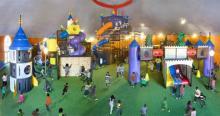
It was 1984 when four innovators in a garage started Soft Play, a company that later would become known as the Architects of Play, thanks to their many years of designing and building playground equipment based on their customers’ needs. Company founders developed a safe alternative to traditional style playground equipment, quickly outgrowing the garage and earning the trust of some of America’s biggest brands.1
Contained playgrounds are vertical enclosed systems with specific entrances and exits so that children climb “in” and not “on” play components. This system uses less space than traditional play spaces and reduces fall-related injuries by keeping the children inside the play structure.2
With more than 18,000 installations in over 60 countries, Soft Play is now recognized as one of the largest contained playground manufacturers in the world.3 Soft Play, a division of PlayPower, Inc., is headquartered in Huntersville, North Carolina, with a 300,000 square foot manufacturing facility in Monett, Missouri.
Soft Play's mission “to provide safe, relevant, age appropriate and active play for children of all ages and abilities” is fulfilled in its inclusive play systems' designs, which feature zoned play for differing age groups and ADA accessibility. Parental interaction and monitoring is facilitated through its visually open designs.4
Operating on the policy of “if the customer can dream it, we can theme it,” Soft Play has created trademark components, such as the Gyro Copter, Air Play, Tuff-skin Padding, Tuff Net, KidErgy Interactive Components, and a patented ADA second level accessible Spiral Climb.5 Soft Play has also been one of the first to introduce motion components, age zoned play areas, visual open play, and electronic play rooms in contained play spaces.6
Offering both indoor and outdoor commercial contained play equipment, Soft Play features small standard play systems, free standing play products, toddler designs, and large custom themed play systems. Soft Play’s standard play systems include traditional contained play designs: Adventure Towers, Club Houses, Family Entertainment Centers, and Active Play Systems.7
Soft Play’s toddler designs include Play Panels, Sculptures, Soft Shapes, and Independent Systems with slides. Free standing components include climbs, accessories, play panels, slides, and over 35 proprietary components.8
Soft Play also has a Re-Play program for updating and improving existing play spaces to ensure a continued safe, quality product.9
Using independent safety consultants for reviewing all new products, Soft Play also runs life-cycle tests to ensure structural integrity and durability of its products. As a founding member of the U.S. Consumer Product Safety Commission (CPSC) Product Safety Circle, through its parent company PlayPower, Inc., Soft Play has committed to “uphold ten fundamental principles, including building safety into product design, performing safety testing, educating consumers, and tracking safety performance.”10 Soft Play is a contributing member of ASTM International (ASTM) for contained play and a 25 year member of International Association of Amusement Parks and Attractions (IAAPA).
- 1. Swintek, James. E-mail message to Playground Professionals. 27 Jan. 2011.
- 2. Ibid.
- 3. “Best In Class.” Soft Play. < http://www.softplay.com/about_us/ > 23 Aug. 2010.
- 4. “Letter From GM.” Soft Play. < http://www.softplay.com/about_us/letter_from_gm.asp > 23 Aug. 2010.
- 5. “Manufacturer Profile: Soft Play.” The Playbook. Fall/Winter 2007-2008: 6-7.
- 6. “Components and Accessories.” Soft Play. < http://www.softplay.com/ncatalog/default.asp/Components%20and%20Accessories > 24 Jan. 2011.
- 7. “Play Systems.” Soft Play. < http://www.softplay.com/ncatalog/default.asp/Play%20Systems > 24 Jan. 2011.
- 8. “Toddler.” Soft Play. < http://www.softplay.com/play-system-products/child-toddler-play-systems.php > 4 Feb. 2011.
- 9. “Re-Play.” Soft Play. < http://www.softplay.com/portfolio/replay.asp > 24 Jan. 2011.
- 10. “Expert Advice.” Soft Play. < http://www.softplay.com/expert_advice/safety.asp > 5 Oct. 2010.

